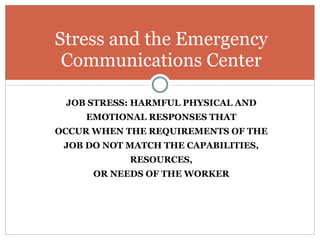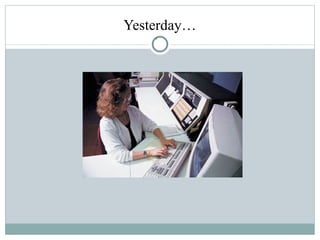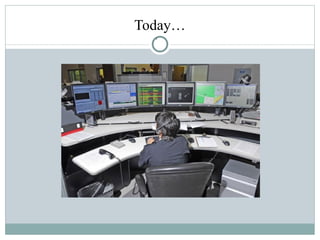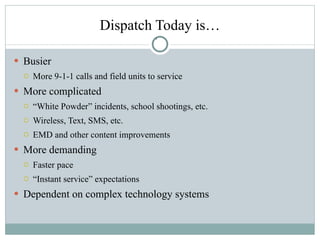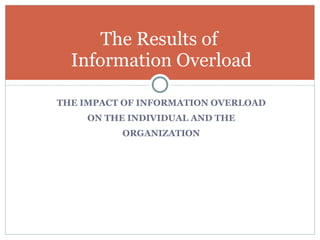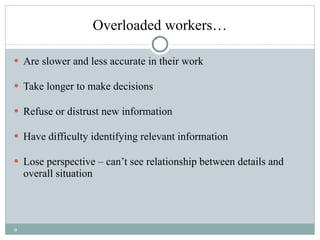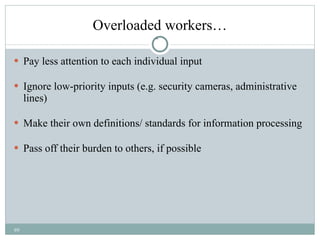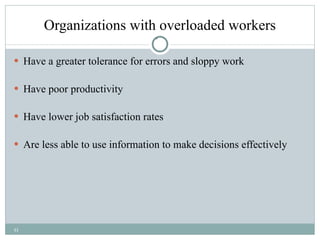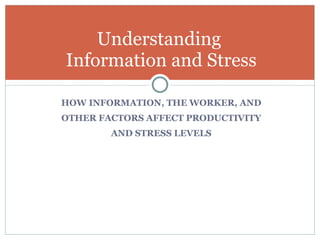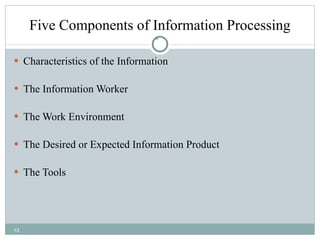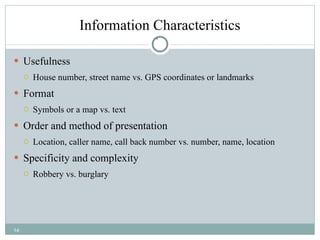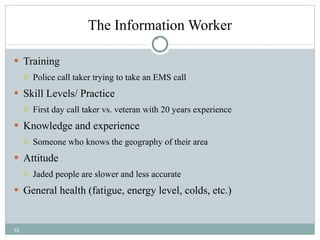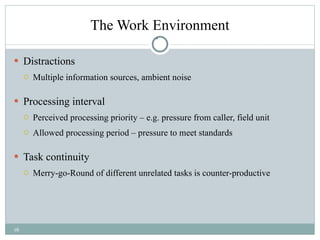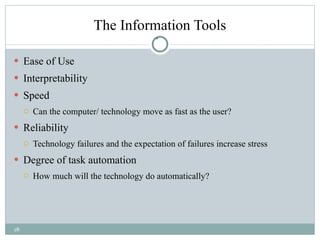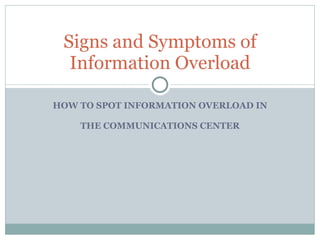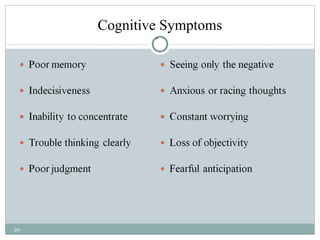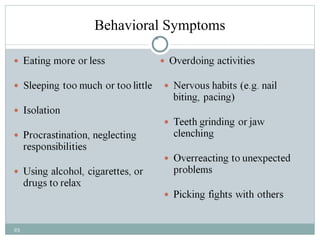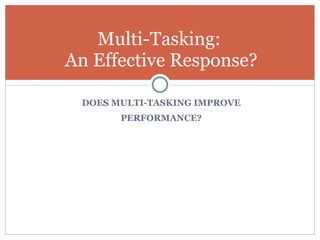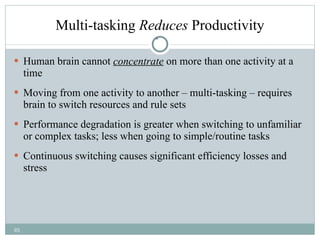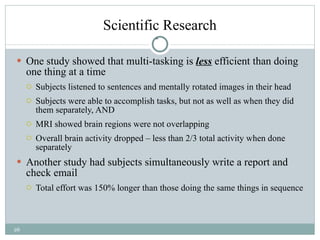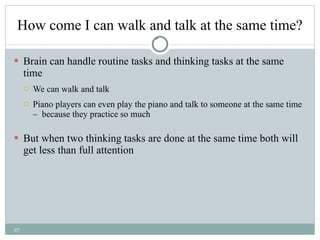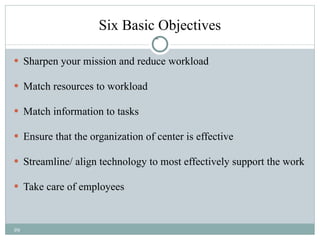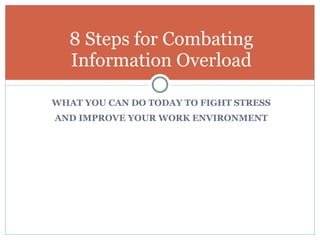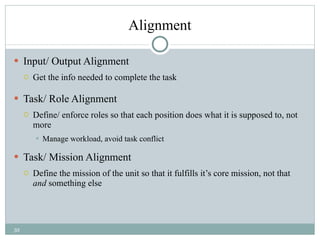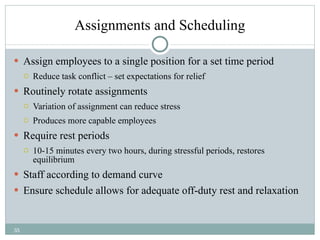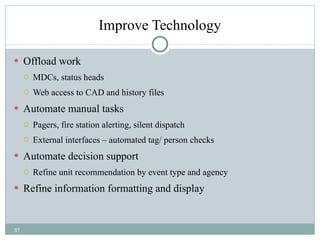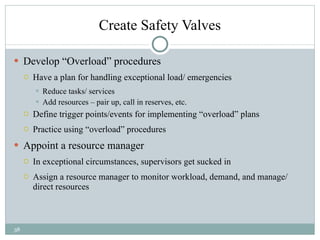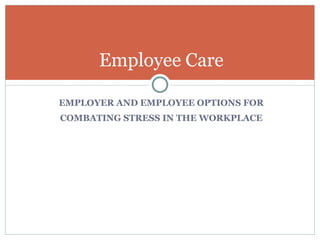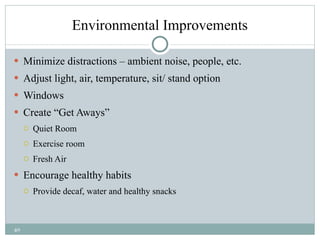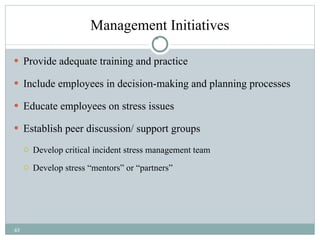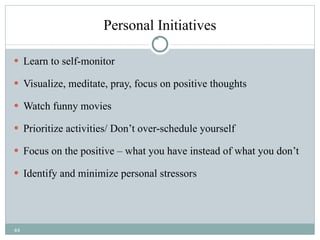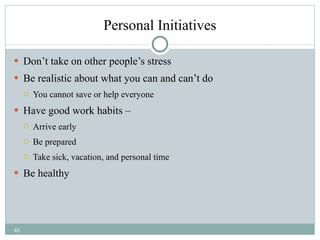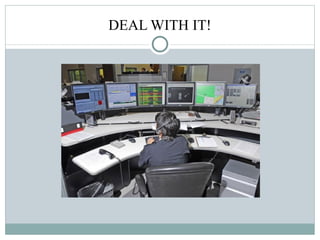Multitasking in the Emergency Communications Environment
- 1. STEVE PENDLETON PENDLETON PARTNERS, INC. RICHMOND, TX W: 281-595-0072 C: 713-855-9552 [email_address] Information Overload, Stress and Multi-tasking
- 2. JOB STRESS: HARMFUL PHYSICAL AND EMOTIONAL RESPONSES THAT OCCUR WHEN THE REQUIREMENTS OF THE JOB DO NOT MATCH THE CAPABILITIES, RESOURCES, OR NEEDS OF THE WORKER Stress and the Emergency Communications Center
- 5. Dispatch Today is… Busier More 9-1-1 calls and field units to service More complicated “ White Powder” incidents, school shootings, etc. Wireless, Text, SMS, etc. EMD and other content improvements More demanding Faster pace “ Instant service” expectations Dependent on complex technology systems
- 6. But… Staffing has not increased in line with demand System improvements have not offset task increases ANI/ALI -> wireless callers MDCs for unit status -> more calls/units per channel Technology Is faster and more capable – But it isn’t easier than the old ways It provides more information – But has increased the overall workload
- 7. End Result Information Overload!!
- 8. THE IMPACT OF INFORMATION OVERLOAD ON THE INDIVIDUAL AND THE ORGANIZATION The Results of Information Overload
- 9. Overloaded workers… Are slower and less accurate in their work Take longer to make decisions Refuse or distrust new information Have difficulty identifying relevant information Lose perspective – can’t see relationship between details and overall situation
- 10. Overloaded workers… Pay less attention to each individual input Ignore low-priority inputs (e.g. security cameras, administrative lines) Make their own definitions/ standards for information processing Pass off their burden to others, if possible
- 11. Organizations with overloaded workers Have a greater tolerance for errors and sloppy work Have poor productivity Have lower job satisfaction rates Are less able to use information to make decisions effectively
- 12. HOW INFORMATION, THE WORKER, AND OTHER FACTORS AFFECT PRODUCTIVITY AND STRESS LEVELS Understanding Information and Stress
- 13. Five Components of Information Processing Characteristics of the Information The Information Worker The Work Environment The Desired or Expected Information Product The Tools
- 14. Information Characteristics Usefulness House number, street name vs. GPS coordinates or landmarks Format Symbols or a map vs. text Order and method of presentation Location, caller name, call back number vs. number, name, location Specificity and complexity Robbery vs. burglary
- 15. The Information Worker Training Police call taker trying to take an EMS call Skill Levels/ Practice First day call taker vs. veteran with 20 years experience Knowledge and experience Someone who knows the geography of their area Attitude Jaded people are slower and less accurate General health (fatigue, energy level, colds, etc.)
- 16. The Work Environment Distractions Multiple information sources, ambient noise Processing interval Perceived processing priority – e.g. pressure from caller, field unit Allowed processing period – pressure to meet standards Task continuity Merry-go-Round of different unrelated tasks is counter-productive
- 17. The Information Product Routine or exceptional? Cold burglary report vs. multi-company fire response with victims Simple or complex? Simple dispatch vs. working a hostage situation or multi-alarm fire Accuracy and completeness High demand for accuracy and completeness will improve product but also increase stress for the worker
- 18. The Information Tools Ease of Use Interpretability Speed Can the computer/ technology move as fast as the user? Reliability Technology failures and the expectation of failures increase stress Degree of task automation How much will the technology do automatically?
- 19. HOW TO SPOT INFORMATION OVERLOAD IN THE COMMUNICATIONS CENTER Signs and Symptoms of Information Overload
- 24. DOES MULTI-TASKING IMPROVE PERFORMANCE? Multi-Tasking: An Effective Response? Pendleton Partners, Inc. steve@pendletonpartners.com
- 25. Multi-tasking Reduces Productivity Human brain cannot concentrate on more than one activity at a time Moving from one activity to another – multi-tasking – requires brain to switch resources and rule sets Performance degradation is greater when switching to unfamiliar or complex tasks; less when going to simple/routine tasks Continuous switching causes significant efficiency losses and stress
- 26. Scientific Research One study showed that multi-tasking is less efficient than doing one thing at a time Subjects listened to sentences and mentally rotated images in their head Subjects were able to accomplish tasks, but not as well as when they did them separately, AND MRI showed brain regions were not overlapping Overall brain activity dropped – less than 2/3 total activity when done separately Another study had subjects simultaneously write a report and check email Total effort was 150% longer than those doing the same things in sequence
- 27. How come I can walk and talk at the same time? Brain can handle routine tasks and thinking tasks at the same time We can walk and talk Piano players can even play the piano and talk to someone at the same time – because they practice so much But when two thinking tasks are done at the same time both will get less than full attention
- 28. HOW TO BREAK THE INFORMATION OVERLOAD CONUNDRUM, REDUCE STRESS AND IMPROVE PRODUCTIVITY Solutions for Information Overload Pendleton Partners, Inc. steve@pendletonpartners.com
- 29. Six Basic Objectives Sharpen your mission and reduce workload Match resources to workload Match information to tasks Ensure that the organization of center is effective Streamline/ align technology to most effectively support the work Take care of employees
- 30. WHAT YOU CAN DO TODAY TO FIGHT STRESS AND IMPROVE YOUR WORK ENVIRONMENT 8 Steps for Combating Information Overload Pendleton Partners, Inc. steve@pendletonpartners.com
- 31. Demand Management / Reduction Develop shared service goals Refine your mission and service offering Involve your customers (public safety and public-surrogates) Assess your strengths, weaknesses, and opportunities Have a honest discussion with all about what you can and cannot do Eliminate non-essential demand Find alternative service method/ provider Eliminate non-essential tasks
- 32. Alignment Input/ Output Alignment Get the info needed to complete the task Task/ Role Alignment Define/ enforce roles so that each position does what it is supposed to, not more Manage workload, avoid task conflict Task/ Mission Alignment Define the mission of the unit so that it fulfills it’s core mission, not that and something else
- 33. Organizational Design Study your task and workload Nature of tasks and workload Utilization rate Chronological distribution Structure organization to effectively complete task and workload Eliminate multiple simultaneous inputs (e.g. multiple radio channels) Questions to think about – Are you the Police switchboard too? Maybe you need switchboard operators Do you handle animal control or non-emergency dispatch? If you handle calls for all services are your call takers trained in each area? Pendleton Partners, Inc. steve@pendletonpartners.com
- 34. Staffing Set shared performance standards (NFPA 1221, etc.) Measure workload – quantify everything Phone calls – emergency and administrative Dispatches, traffic stops, radio air time, field requests, etc. Non-emergency and secondary tasks Measure task processing intervals – everything takes time Calls for service = Connect time, ring time, interrogation, and wrap-up Use a stopwatch if necessary Use scientific algorithms – not emotions or perceptions Peak/ Off-peak staffing
- 35. Assignments and Scheduling Assign employees to a single position for a set time period Reduce task conflict – set expectations for relief Routinely rotate assignments Variation of assignment can reduce stress Produces more capable employees Require rest periods 10-15 minutes every two hours, during stressful periods, restores equilibrium Staff according to demand curve Ensure schedule allows for adequate off-duty rest and relaxation
- 36. Improve your Information Consider using interrogation protocols Record only the information that others will need to process call Develop meaningful groups and classifications for information Refine event types to encapsulate more meaning Event status to communicate urgency of event Routinely review and refine input/ outcome
- 37. Improve Technology Offload work MDCs, status heads Web access to CAD and history files Automate manual tasks Pagers, fire station alerting, silent dispatch External interfaces – automated tag/ person checks Automate decision support Refine unit recommendation by event type and agency Refine information formatting and display
- 38. Create Safety Valves Develop “Overload” procedures Have a plan for handling exceptional load/ emergencies Reduce tasks/ services Add resources – pair up, call in reserves, etc. Define trigger points/events for implementing “overload” plans Practice using “overload” procedures Appoint a resource manager In exceptional circumstances, supervisors get sucked in Assign a resource manager to monitor workload, demand, and manage/ direct resources
- 39. EMPLOYER AND EMPLOYEE OPTIONS FOR COMBATING STRESS IN THE WORKPLACE Employee Care Pendleton Partners, Inc. steve@pendletonpartners.com
- 40. Environmental Improvements Minimize distractions – ambient noise, people, etc. Adjust light, air, temperature, sit/ stand option Windows Create “Get Aways” Quiet Room Exercise room Fresh Air Encourage healthy habits Provide decaf, water and healthy snacks
- 41. Process Improvements Include routine breaks in shift schedule Assign a break after a stressful event Set clear standards for work processes Time goals Accuracy Attitude Ideal work product Reduce task conflict and multi-tasking by continuity of position and task
- 42. Management Initiatives Provide adequate training and practice Include employees in decision-making and planning processes Educate employees on stress issues Establish peer discussion/ support groups Develop critical incident stress management team Develop stress “mentors” or “partners”
- 43. Management Initiatives Identify and resolve interpersonal conflicts Encourage positive interaction and shared improvement Monitor employees for stress-related behaviors Develop effective interventions Applaud positive effort and results Carefully manage overtime
- 44. Personal Initiatives Learn to self-monitor Visualize, meditate, pray, focus on positive thoughts Watch funny movies Prioritize activities/ Don’t over-schedule yourself Focus on the positive – what you have instead of what you don’t Identify and minimize personal stressors
- 45. Personal Initiatives Don’t take on other people’s stress Be realistic about what you can and can’t do You cannot save or help everyone Have good work habits – Arrive early Be prepared Take sick, vacation, and personal time Be healthy
- 46. DEAL WITH IT!
![STEVE PENDLETON PENDLETON PARTNERS, INC. RICHMOND, TX W: 281-595-0072 C: 713-855-9552 [email_address] Information Overload, Stress and Multi-tasking](https://image.slidesharecdn.com/multitaskingpresentation97-124581432811-phpapp01/85/Multitasking-in-the-Emergency-Communications-Environment-1-320.jpg)
